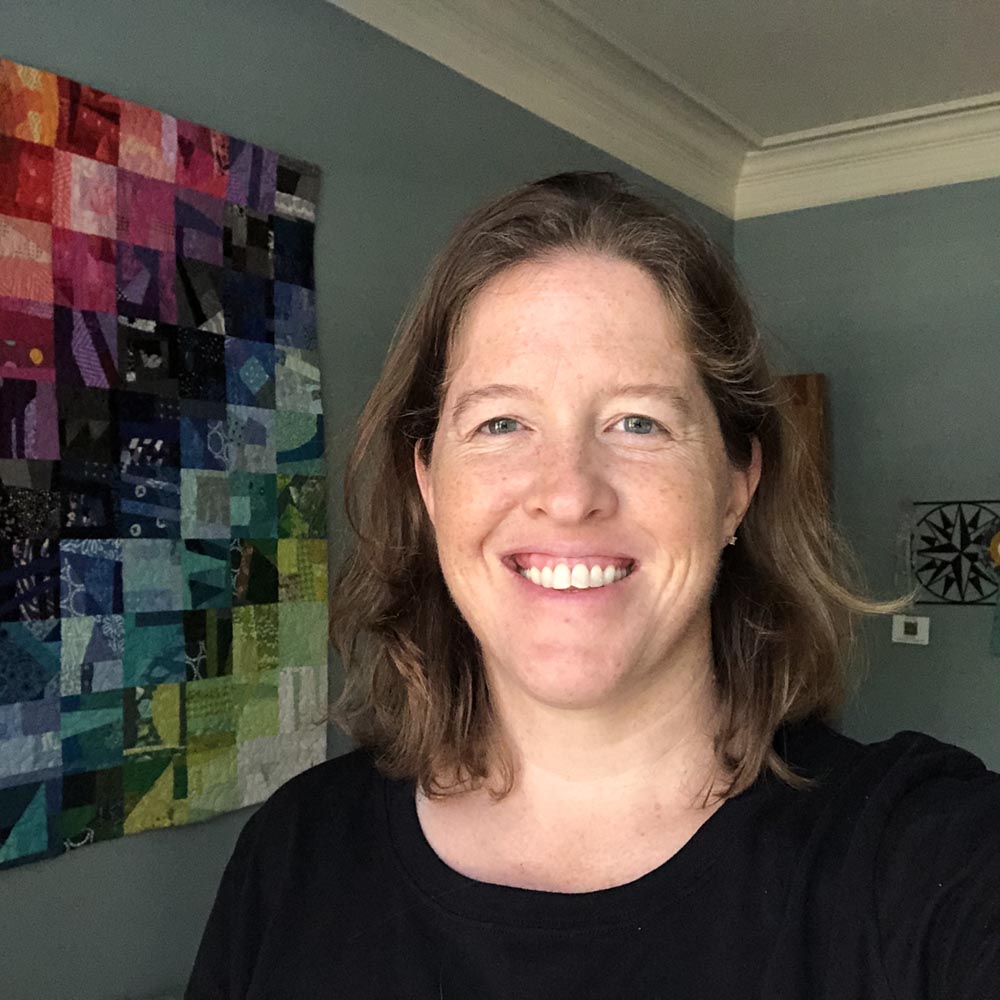October is always busy and hectic, and the QuiltCon deadlines now looms at the end of that month each year…and this year, instead of relaxing, I somehow ended up making a mini quilt and actually finishing it in time to make that deadline. This mini grew out of a half-square triangle idea that I’d been toying around with for a while. The design was *almost* right, but not quite, and I kept putting it aside in favor of other options — but finally in early October I hit upon a motif and color palette that I thought would work. Here’s the result:

It’s only 24″ tall from top to bottom point, so triangles are pretty small! Each two-tone strip of triangles is foundation paper pieced. It wasn’t the most exciting quilt to put together — in fact it was rather tedious at times — but I definitely appreciated the end result.
I called it Systematic Scatterbrain because it seemed to capture both the ordered way that my brain works while also hinting at the chaos that’s in there too. And while it wasn’t accepted into the show this year, that may turn out to be an ok thing because I’m not entirely sure this quilt is finished yet. I think it may benefit from more quilting? I’ve also considered rotating it 60 or 90 degrees. It’s been hanging in my sewing room for the last couple months as I consider whether to go back and add something else to it.


My only trouble spot was figuring out how to quilt this piece, and I’m still not entirely satisfied with that part — hence my musings about adding more quilting. The sheer quantity of seams means that there’s a lot of bulk in this quilt, even though I trimmed my seam allowances to 1/8″. You can see above that I currently have two quilting lines running through each section, and I chose a very thin turquoise thread that doesn’t stand out too much, especially from a distance.

I know from experience that my tendency is to quilt too sparsely, so I’ve been contemplating whether denser, essentially matchstick quilting would be an improvement. Another option would be to do a second set of quilting lines that echo the diagonal lines of the piecing. The diagonal shifts a bit — it is not a straight line across the quilt — which would mean that those quilting lines would start to bend. That might actually create a cool effect…or it might not. I may just have to try a few things and accept ripping some stitches to figure out what works best!
I used a facing instead of a binding for this quilt, and the hexagonal shape required me to think through how to handle each corner! I haven’t taken photos of that part — in fact I didn’t take a single construction photo of this quilt at all, which is highly unusual for me. But I hope to snap a few and share that facing technique soon. (Though I’ll have to remove the facing if/when I add more quilting. C’est la vie.)


As for the orientation — what do you think? Points at the top and bottom like the image at the top of this post? Or is one of the orientations below more visually appealing? I see pros and cons to all of them!
The stats:
- Quilt measures 27″ x 24″.
- Fabrics are Kona Cotton.
- Backing and facing are Widescreen by Carolyn Friedlander.
- Batting is Hobbs 80/20 cotton/poly.
- Pieced with Aurifil 50 wt thread in #2600 (Dove).
- Quilted on my Juki TL-2010Q with Wonderfil thread in turquoise.







 #saroy1sec #1secondev
#saroy1sec #1secondev


I really like either orientation that results in an hourglass like shape in the middle, and the orientation with the points running horizontally really emphasizes that shape beautifully. But, like you said, there is basically no wrong way to orient or look at this quilt. Maybe you need to engineer a mounting plate or system that allows it to rotate easily….
Ok now THAT would be cool…..
That is super cool! I really like the orientation in the last photo.
I like both orientations. Beautiful quilt..
I also like the one with the hourglass in the middle (bottom left)
It invites me to look more closely trying to determine how the design is constructed.